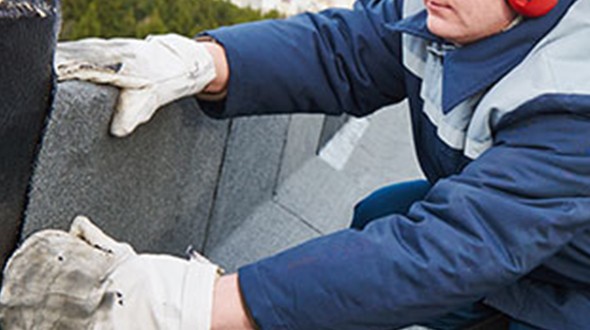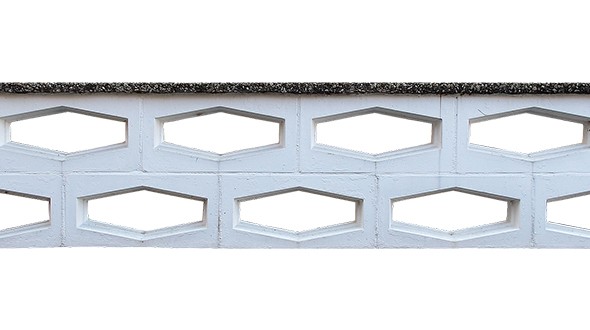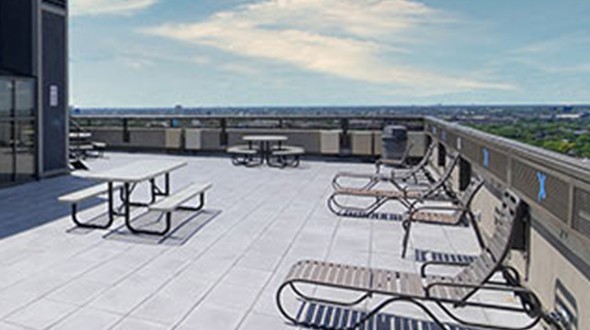What Is A Parapet Wall? This architectural element offers more than just aesthetics; it plays a vital role in safety and building protection. At WHAT.EDU.VN, we provide clear and concise answers to your questions, helping you understand the functionality and different types of parapet walls, ensuring structural integrity and preventing water damage. Explore roofing structures, building codes, and wall extension types, and feel free to ask any further questions on WHAT.EDU.VN for free.
1. Understanding Parapet Walls: An Overview
Parapet walls are low protective walls extending above the roofline of a building, typically found around the perimeter of flat roofs. They are not only an architectural feature but also serve several crucial functions, from enhancing safety to protecting the roofing system. Parapet walls can be designed in various styles, from plain and functional to ornate and decorative, adding to the building’s overall aesthetic appeal.
1.1. Definition and Purpose
A parapet wall is essentially an extension of the wall that runs along the edge of a roof. It acts as a barrier, providing safety and protection. Common on flat or low-sloped roofs, parapet walls can also be found on balconies, bridges, and walkways.
1.2. Key Functions of Parapet Walls
Parapet walls serve multiple essential functions:
- Safety: Preventing falls from the roof or other elevated surfaces.
- Fire Protection: Acting as a fire barrier to slow the spread of fire between buildings.
- Wind Resistance: Reducing wind loads on the roof and protecting against wind damage.
- Aesthetics: Enhancing the building’s appearance and architectural style.
- Screening: Hiding rooftop equipment and creating a cleaner look.
- Weather Protection: Helping to manage snow and water runoff.
1.3. Common Locations for Parapet Walls
While primarily seen on flat roofs, parapet walls can be found in various locations:
- Commercial Buildings: Offering safety and screening rooftop equipment.
- Residential Buildings: Enhancing aesthetics and providing safety on balconies and terraces.
- Bridges: Preventing vehicles and pedestrians from falling off the sides.
- Walkways: Providing a safety barrier along elevated paths.
- Historic Buildings: Preserving architectural heritage and maintaining original designs.
- Modern Homes: Adding an architectural element and creating a private outdoor space.
2. Types of Parapet Walls: Styles and Materials
Parapet walls come in various styles and are constructed from different materials to suit specific architectural designs and functional requirements. Understanding the different types can help you choose the best option for your building.
2.1. Plain Parapet Walls
Plain parapet walls are the simplest type, consisting of a vertical extension of the wall above the roofline. They are primarily functional, offering safety and protection without elaborate design elements.
2.2. Perforated Parapet Walls
Perforated parapet walls feature openings or perforations in the wall, providing visual interest while still serving as a barrier. These openings can be various sizes and shapes, adding to the building’s aesthetic appeal.
2.3. Embattled Parapet Walls
Embattled parapet walls, also known as crenellated parapets, are inspired by medieval fortifications. They feature alternating high and low sections, originally designed to provide cover for defenders. Today, they are often used for their historical and decorative appeal.
2.4. Paneled Parapet Walls
Paneled parapet walls are adorned with decorative panels on the exterior surface. These panels can be made from various materials, such as stone, brick, or metal, and can feature intricate designs, enhancing the building’s architectural style.
2.5. Sloped Parapet Walls
Sloped parapet walls are designed for use on sloped roofs. They follow the angle of the roofline, providing a consistent barrier and maintaining the building’s aesthetic flow.
2.6. Stepped Parapet Walls
Stepped parapet walls are constructed in a series of steps, creating a visually interesting design element. They are often used on buildings with sloped or irregular rooflines, providing a unique architectural feature.
2.7. Arched Parapet Walls
Arched parapet walls feature curved or arched designs, adding a touch of elegance to the building’s exterior. They can be used on both flat and sloped roofs, providing a distinctive architectural element.
2.8. Material Options for Parapet Walls
Parapet walls can be constructed from a variety of materials:
- Brick: Durable and aesthetically pleasing, suitable for traditional designs.
- Concrete: Strong and versatile, ideal for modern and industrial buildings.
- Steel: Lightweight and strong, often used for commercial and industrial structures.
- Aluminum: Corrosion-resistant and lightweight, suitable for various climates.
- Glass: Used in perforated or paneled designs to add a modern touch.
- Stone: Provides a classic and durable option for high-end designs.
- Wood: Offers a natural and warm aesthetic, suitable for residential buildings.
- Composite Materials: Combining durability and aesthetic appeal, often used for modern designs.
3. The Importance of Parapet Walls: Safety and Protection
Parapet walls are more than just an architectural detail; they provide essential safety and protection for buildings and their occupants. Their functions range from preventing falls to protecting against fire and wind damage.
3.1. Fall Protection
One of the primary functions of parapet walls is to prevent falls from roofs, balconies, and other elevated surfaces. They act as a barrier, providing a safe edge for people working or relaxing on the roof.
3.2. Fire Resistance
Parapet walls can act as a fire barrier, slowing the spread of fire between buildings. By extending above the roofline, they help prevent flames from jumping to adjacent structures, providing crucial time for evacuation and firefighting efforts.
3.3. Wind Load Reduction
Parapet walls help reduce wind loads on the roof, protecting against wind damage. By deflecting wind away from the roof surface, they minimize the risk of uplift and structural damage, ensuring the building’s stability.
3.4. Aesthetic Enhancement
Parapet walls enhance a building’s appearance, adding architectural interest and style. They can be designed in various styles and materials to complement the building’s overall aesthetic, increasing its curb appeal.
3.5. Screening of Rooftop Equipment
Parapet walls can screen rooftop equipment, such as HVAC systems and antennas, hiding them from view and creating a cleaner, more aesthetically pleasing look. This is particularly important for commercial buildings where rooftop equipment can detract from the building’s appearance.
3.6. Weather Protection
Parapet walls help manage snow and water runoff, preventing water damage to the building. They can be designed with drainage systems, such as scuppers, to effectively channel water away from the roof, protecting the structure from leaks and moisture damage.
4. Parapet Wall Drainage Systems: Scuppers and Gutters
Effective drainage is crucial for parapet walls to prevent water damage. Scuppers and gutters are two common drainage systems used to manage water runoff and protect the building’s structure.
4.1. Scuppers: Directing Water Flow
Scuppers are openings in the parapet wall that allow water to drain directly from the roof. They are typically rectangular in shape and are placed at the edge of the roof to facilitate efficient water runoff.
4.2. Gutters and Downspouts: Channeling Water Away
Gutters and downspouts are used in conjunction with scuppers to channel water away from the building’s foundation. Gutters collect water from the roof and direct it to downspouts, which carry the water to the ground, preventing soil erosion and water damage.
4.3. Importance of Proper Drainage
Proper drainage is essential for the longevity and structural integrity of parapet walls. Poor drainage can lead to water accumulation, which can cause leaks, moisture damage, and structural deterioration. Regular maintenance and inspection of drainage systems are crucial to ensure their effectiveness.
4.4. Maintenance Tips for Drainage Systems
- Regular Inspections: Check scuppers and gutters regularly for clogs and debris.
- Cleaning: Remove leaves, branches, and other debris from gutters and scuppers.
- Repairing Damage: Repair any cracks, leaks, or damage to gutters and downspouts promptly.
- Sealing Joints: Seal joints and seams in gutters to prevent leaks.
- Professional Maintenance: Schedule professional maintenance and inspection of drainage systems periodically.
5. Building Codes and Parapet Walls: Compliance and Regulations
Parapet walls are subject to building codes and regulations that ensure their safety and structural integrity. Compliance with these codes is essential for obtaining building permits and ensuring the building’s safety.
5.1. Height Requirements
Building codes typically specify minimum height requirements for parapet walls to ensure adequate fall protection. These requirements vary depending on the building’s occupancy and the height of the roof.
5.2. Structural Requirements
Parapet walls must meet structural requirements to withstand wind loads, seismic forces, and other environmental factors. These requirements specify the materials, construction methods, and reinforcement needed to ensure the wall’s stability.
5.3. Fire Resistance Requirements
Parapet walls that serve as fire barriers must meet fire resistance requirements to slow the spread of fire. These requirements specify the materials and construction methods needed to achieve a certain fire resistance rating.
5.4. Drainage Requirements
Building codes may also specify drainage requirements for parapet walls to prevent water damage. These requirements may include the use of scuppers, gutters, and other drainage systems to manage water runoff effectively.
5.5. Local Regulations
It is essential to check local building codes and regulations to ensure compliance with specific requirements for parapet walls in your area. These regulations may vary depending on the local climate, soil conditions, and other factors.
5.6. Ensuring Compliance
To ensure compliance with building codes, it is advisable to consult with a qualified architect or engineer who can provide guidance on the design and construction of parapet walls. They can help you navigate the complex requirements and ensure that your building meets all necessary standards.
6. Parapet Wall Maintenance and Repair: Ensuring Longevity
Regular maintenance and prompt repair are essential for ensuring the longevity and structural integrity of parapet walls. Neglecting maintenance can lead to water damage, structural deterioration, and costly repairs.
6.1. Regular Inspections
Regular inspections are crucial for identifying potential problems early on. Check the parapet walls for cracks, leaks, and other signs of damage. Pay close attention to areas around joints, seams, and drainage systems.
6.2. Cleaning and Debris Removal
Keep parapet walls clean and free of debris. Remove leaves, branches, and other debris that can accumulate on the wall and in drainage systems. This will help prevent clogs and ensure proper water runoff.
6.3. Crack Repair
Repair any cracks in the parapet walls promptly. Small cracks can be filled with sealant or patching compound, while larger cracks may require more extensive repairs. Ignoring cracks can lead to water infiltration and structural damage.
6.4. Water Damage Repair
Address any water damage promptly to prevent further deterioration. Repair leaks, replace damaged materials, and ensure proper drainage to prevent water accumulation. Water damage can weaken the wall’s structure and lead to costly repairs.
6.5. Repointing Mortar Joints
Repoint mortar joints as needed to maintain the wall’s structural integrity. Over time, mortar joints can deteriorate due to weathering and exposure to the elements. Repointing involves removing the old mortar and replacing it with new mortar to seal the joints and prevent water infiltration.
6.6. Sealing and Waterproofing
Apply sealant and waterproofing to protect parapet walls from water damage. Sealants can be used to seal joints, seams, and cracks, while waterproofing can be applied to the entire wall surface to create a barrier against water penetration.
6.7. Professional Maintenance
Schedule professional maintenance and inspection of parapet walls periodically. A qualified contractor can identify potential problems that may not be visible to the untrained eye and provide expert repairs and maintenance services.
7. Parapet Walls in Architectural Design: Styles and Trends
Parapet walls have evolved from purely functional elements to integral parts of architectural design, influencing a building’s style and aesthetic appeal.
7.1. Historical Styles
Historically, parapet walls were used in various architectural styles:
- Medieval Castles: Embattled parapets provided defensive cover.
- Renaissance Palaces: Ornate parapets added grandeur and elegance.
- Gothic Cathedrals: Intricate parapets enhanced the building’s verticality.
7.2. Modern Trends
Modern architectural trends incorporate parapet walls in new and innovative ways:
- Minimalist Designs: Clean, simple parapets create a sleek and modern look.
- Green Roofs: Parapets provide a barrier for green roofs, enhancing sustainability.
- Rooftop Terraces: Parapets create safe and private outdoor spaces.
7.3. Integrating Parapet Walls into Design
When incorporating parapet walls into architectural design, consider:
- Building Style: Choose a parapet style that complements the building’s overall design.
- Materials: Select materials that enhance the building’s aesthetic appeal and durability.
- Functionality: Ensure the parapet meets all necessary safety and structural requirements.
7.4. The Role of Color and Texture
Color and texture can significantly impact the visual appeal of parapet walls:
- Contrasting Colors: Create a bold and modern look.
- Matching Colors: Blend the parapet seamlessly with the building’s facade.
- Textured Materials: Add depth and interest to the parapet design.
7.5. Lighting and Parapet Walls
Lighting can enhance the architectural features of parapet walls:
- Uplighting: Highlights the parapet’s shape and texture.
- Downlighting: Creates a warm and inviting ambiance.
- Integrated Lighting: Adds a modern and sophisticated touch.
8. Common Problems with Parapet Walls: Causes and Solutions
Despite their many benefits, parapet walls can experience various problems that require prompt attention to prevent further damage.
8.1. Water Damage
Water damage is one of the most common problems with parapet walls:
- Causes: Leaks, poor drainage, and weathering.
- Solutions: Repair leaks, improve drainage, and apply waterproofing.
8.2. Cracking
Cracking can compromise the structural integrity of parapet walls:
- Causes: Structural stress, thermal expansion, and settling.
- Solutions: Repair cracks with sealant or patching compound, and address underlying structural issues.
8.3. Spalling
Spalling, or the crumbling of concrete or brick, can occur in parapet walls:
- Causes: Water infiltration, freeze-thaw cycles, and salt exposure.
- Solutions: Remove damaged material, repair the surface, and apply a protective coating.
8.4. Mortar Joint Deterioration
Deterioration of mortar joints can lead to water infiltration and structural instability:
- Causes: Weathering, erosion, and age.
- Solutions: Repoint mortar joints to seal the joints and prevent water damage.
8.5. Inadequate Drainage
Inadequate drainage can cause water accumulation and damage:
- Causes: Clogged scuppers, damaged gutters, and poor slope.
- Solutions: Clean scuppers, repair gutters, and improve the roof’s slope for proper drainage.
8.6. Preventing Problems
Regular maintenance and prompt repair are essential for preventing problems with parapet walls:
- Regular Inspections: Identify potential problems early on.
- Cleaning: Remove debris and prevent clogs.
- Prompt Repairs: Address any damage promptly to prevent further deterioration.
9. Cost Considerations for Parapet Walls: Installation and Maintenance
The cost of parapet walls can vary depending on several factors, including materials, design complexity, and labor costs.
9.1. Installation Costs
Installation costs for parapet walls can range from $50 to $200 per linear foot, depending on the materials and design:
- Materials: Brick, concrete, steel, and other materials have different costs.
- Design Complexity: Intricate designs and custom features increase costs.
- Labor Costs: Local labor rates and the project’s complexity affect installation costs.
9.2. Maintenance Costs
Maintenance costs for parapet walls can include:
- Inspections: $100 to $500 per inspection.
- Cleaning: $100 to $300 per cleaning.
- Repairs: $500 to $5,000+ per repair, depending on the extent of the damage.
9.3. Long-Term Savings
Investing in high-quality materials and regular maintenance can lead to long-term savings:
- Durability: High-quality materials last longer and require less frequent repairs.
- Prevention: Regular maintenance prevents costly damage and extends the wall’s lifespan.
9.4. Budgeting for Parapet Walls
When budgeting for parapet walls, consider:
- Initial Costs: Installation costs, including materials and labor.
- Ongoing Costs: Maintenance costs, including inspections, cleaning, and repairs.
- Long-Term Savings: The potential for long-term savings through durability and prevention.
9.5. Cost-Effective Strategies
Cost-effective strategies for parapet walls include:
- Simple Designs: Opt for simpler designs to reduce material and labor costs.
- Durable Materials: Choose durable materials that require less frequent repairs.
- Regular Maintenance: Implement a regular maintenance plan to prevent costly damage.
10. Frequently Asked Questions About Parapet Walls
Here are some frequently asked questions about parapet walls to help you better understand these architectural elements.
| Question | Answer |
|---|---|
| What is the primary purpose of a parapet wall? | The primary purpose is to provide safety by preventing falls from roofs and other elevated surfaces. |
| What materials are commonly used to build parapet walls? | Common materials include brick, concrete, steel, aluminum, and stone. |
| How do parapet walls contribute to fire safety? | Parapet walls act as a fire barrier, slowing the spread of fire between buildings by preventing flames from jumping to adjacent structures. |
| What is the role of parapet walls in managing water runoff? | Parapet walls help manage snow and water runoff by directing water to drainage systems like scuppers and gutters, preventing water damage to the building. |
| How do building codes regulate the construction of parapet walls? | Building codes specify minimum height requirements, structural requirements, fire resistance requirements, and drainage requirements for parapet walls to ensure their safety and structural integrity. |
| What are some common maintenance tasks for parapet walls? | Common maintenance tasks include regular inspections, cleaning and debris removal, crack repair, water damage repair, repointing mortar joints, and sealing and waterproofing. |
| How can I prevent water damage to my parapet walls? | Prevent water damage by ensuring proper drainage, repairing leaks promptly, applying sealant and waterproofing, and maintaining the wall’s structural integrity. |
| What are the aesthetic benefits of parapet walls? | Parapet walls enhance a building’s appearance by adding architectural interest and style. They can be designed in various styles and materials to complement the building’s overall aesthetic, increasing its curb appeal. |
| How do parapet walls contribute to wind resistance? | Parapet walls help reduce wind loads on the roof by deflecting wind away from the roof surface, minimizing the risk of uplift and structural damage. |
| What should I consider when budgeting for parapet walls? | When budgeting for parapet walls, consider the initial costs of installation, ongoing maintenance costs, and the potential for long-term savings through durability and prevention. |



Understanding parapet walls and their functions is crucial for building safety and architectural design. From preventing falls to protecting against fire and wind damage, parapet walls offer numerous benefits. If you have more questions or need expert advice, visit WHAT.EDU.VN, where you can ask any question and receive free answers. Contact us at 888 Question City Plaza, Seattle, WA 98101, United States, or reach out via WhatsApp at +1 (206) 555-7890. Let what.edu.vn be your go-to resource for all your informational needs.
